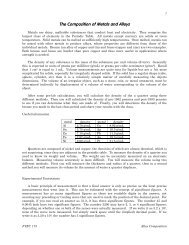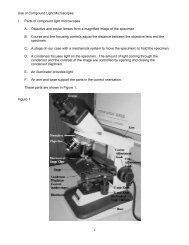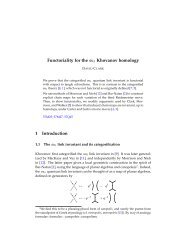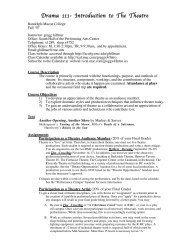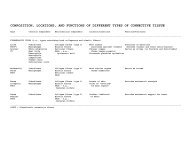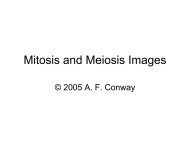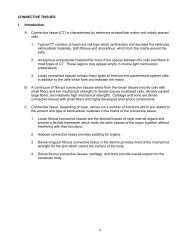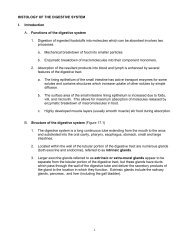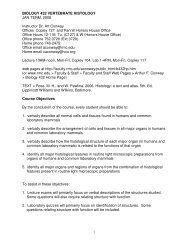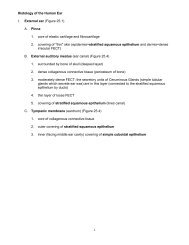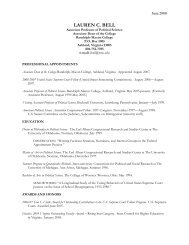Histology of Sensory Receptors I. Introduction A ... - Faculty.rmc.edu
Histology of Sensory Receptors I. Introduction A ... - Faculty.rmc.edu
Histology of Sensory Receptors I. Introduction A ... - Faculty.rmc.edu
Create successful ePaper yourself
Turn your PDF publications into a flip-book with our unique Google optimized e-Paper software.
<strong>Histology</strong> <strong>of</strong> <strong>Sensory</strong> <strong>Receptors</strong><br />
I. <strong>Introduction</strong><br />
A. <strong>Sensory</strong> receptors always contain a transducing system which converts the stimulus into an<br />
altered transmembrane electrical potential in the receptor cell. In the structurally simplest<br />
types <strong>of</strong> receptors (free nerve endings) the transducing system is apparently built into the<br />
membrane <strong>of</strong> dendrite-like branches at the peripheral end <strong>of</strong> the axon <strong>of</strong> the sensory neuron.<br />
When the transducing system is stimulated, the altered transmembrane potential causes an<br />
action potential in the axon which transmits the action potential back to the CNS.<br />
B. The transducing system does not have to be in an anatomically recognizable neuron, but<br />
may instead be in an altered epithelial cell (or perhaps other type <strong>of</strong> cell) which has some<br />
neuron-like properties and which communicates with a sensory neuron through a chemical<br />
synapse (i.e. taste buds, hair cells in the ear).<br />
C. The stimulus may not fall directly on the receptor cell surface, but may first be processed and<br />
altered by an accessory structure before reaching the receptor cell. The accessory structure<br />
may act to increase the chance <strong>of</strong> a stimulus reaching the receptor cell, restrict the type or<br />
direction <strong>of</strong> stimuli which reach the receptor cell, or alter the form <strong>of</strong> the stimulus (sound<br />
waves -> mechanical vibration <strong>of</strong> hair cells in the ear).<br />
II.<br />
Free Nerve Endings<br />
A. Naked nerve endings (Figure 15.12)<br />
1. Naked nerve endings are highly branched, dendrite-like endings <strong>of</strong> sensory neurons and<br />
are not covered by Schwann cells. These endings are usually associated with epidermal<br />
cells or with connective tissue fibers.<br />
2. Naked nerve endings function as touch receptors in the cornea and as pain receptors<br />
(probably by chemoreception <strong>of</strong> bradykinin released by damaged tissues) in skin and<br />
other areas.<br />
B. Merkel's disks (Figure 15.12)<br />
1. Merkel's disks are naked nerve endings which have expanded disk-like termini in contact<br />
with Merkel cells in the basal layer <strong>of</strong> the epidermis. The Merkel cells do not appear to<br />
be epidermal cells but are probably derived from neural crest (same source as PNS<br />
neurons).<br />
2. Merkel's disks function as touch receptors in the tongue and as slowly adapting<br />
mechanoreceptors which react to skin deformation.<br />
C. Basket arrays<br />
1. Basket arrays are naked nerve endings which spiral around the base <strong>of</strong> hair follicles.<br />
2. Basket arrays apparently function as touch and movement receptors.<br />
1
III. Myoneural <strong>Receptors</strong><br />
A. Golgi tendon organs<br />
1. Golgi tendon organs are small spindle-shaped aggregates containing several bundles <strong>of</strong><br />
collagen fibers with free nerve endings wrapped around the collagen fibers. The whole<br />
complex is surrounded by a thin capsule <strong>of</strong> flattened fibroblastic cells.<br />
2. Golgi tendon organs occur in the tendons <strong>of</strong> skeletal muscles and respond to tension in<br />
the tendon.<br />
B. Neuromuscular spindles (muscle spindles) (Figure 11.12)<br />
1. Neuromuscular spindles contain two types <strong>of</strong> modified skeletal muscle cells which have<br />
organized my<strong>of</strong>ibrils in their distal ends but contain few organized my<strong>of</strong>ibrils in their<br />
central regions (where their nuclei are located).<br />
a. Nuclear bag fibers contain nuclei clumped in the center <strong>of</strong> the cell.<br />
b. Nuclear chain fibers contain nuclei in a row in the center region <strong>of</strong> the cell.<br />
(1) Primary sensory nerve endings spiral around the central region <strong>of</strong> both types <strong>of</strong><br />
modified cells.<br />
(2) Secondary sensory nerve endings are attached as highly branched "flower<br />
spray" endings on the surface <strong>of</strong> the nuclear chain fibers on both ends just<br />
distal to the central (nuclear) region.<br />
(3) Both fiber types have motor synapses (gamma efferent) on both distal regions<br />
(where the my<strong>of</strong>ibrils are highly organized) which cause the cell ends to<br />
contract, stretching the sensory receptor region in the nuclear region <strong>of</strong> the cell<br />
and stimulating the receptor.<br />
(4) The receptor complex is surrounded by a capsule <strong>of</strong> flattened cells continuous<br />
with the Schwann cells <strong>of</strong> the peripheral nerve supplying the muscle and the<br />
perimysium (the part <strong>of</strong> the connective tissue framework <strong>of</strong> the muscle which<br />
surrounds each bundle <strong>of</strong> muscle cells and the part which attaches to the<br />
tendon at each end <strong>of</strong> the muscle) <strong>of</strong> the muscle. The modified muscle cells in<br />
the receptor are attached to the capsule at their ends and are therefore<br />
attached to the perimysium <strong>of</strong> the muscle.<br />
2. Neuromuscular spindles monitor tension and stretch in the skeletal muscle since either<br />
force pulls on the perimysium which pulls on the muscle cells in the receptor.<br />
2
IV. Encapsulated <strong>Receptors</strong><br />
A. Pacinian corpuscles (Figure 15.13, Plate 42)<br />
1. Pacinian corpuscles contain a central cylindrical sensory nerve ending surrounded by a<br />
capsule "wall" <strong>of</strong> concentric layers <strong>of</strong> flattened "fibroblastic" cells interspersed with<br />
sparse fine collagen fibers and ground substance.<br />
2. Pacinian corpuscles function as pressure and vibration receptors in subcutaneous and<br />
internal connective tissues.<br />
B. Meissner's corpuscles (Figure 15.13, Plate 42)<br />
1. Meissner's corpuscles contain highly branched, frequently spirally arranged nerve<br />
endings winding among transversely stacked flat fibroblastic cells which form an eliptical<br />
aggregate which may be surrounded by a thin capsule <strong>of</strong> connective tissue (loose to<br />
moderately dense, rich in flattened fibroblasts).<br />
2. The function <strong>of</strong> Meissner's corpuscles is not rigorously defined, but they are presumed to<br />
function as light touch receptors since they are most numerous in the dermal papillae <strong>of</strong><br />
the skin on fingers, lips, and genitalia.<br />
C. Ruffinian corpuscles (Figure 15.12)<br />
1. The structure <strong>of</strong> Ruffinian corpuscles is very similar to Golgi tendon organs. They<br />
contain a highly branched nerve ending wound around a spindle-shaped bundle <strong>of</strong><br />
collagen fibers. The entire complex is wrapped in a connective tissue capsule <strong>of</strong> fine<br />
collagen fibers plus flattened fibroblasts.<br />
2. Ruffinian corpuscles are located in deep connective tissues below skin, in joint capsules,<br />
and in the walls <strong>of</strong> some blood vessels. Their function is unclear, but their location and<br />
structure suggests that they may detect vibration or distortion <strong>of</strong> connective tissues.<br />
D. Krause's end bulbs (genital corpuscles) (Figure 15.12)<br />
1. Krause's end bulbs contain a highly branched nerve ending in a fluid-filled cavity<br />
surrounded by a spherical capsule <strong>of</strong> collagen fibers and fibroblasts.<br />
2. Krause's end bulbs are located in dermis <strong>of</strong> skin and in tendons and ligaments. Their<br />
function is unknown, but they are assumed to be mechanoreceptors.<br />
V. Baroreceptors<br />
A. Baroreceptors are highly branched free nerve endings in the tunica adventitia <strong>of</strong> all large<br />
arteries <strong>of</strong> the head and neck.<br />
B. Baroreceptors apparently detect blood pressure by monitoring the stretch in the wall <strong>of</strong> the<br />
vessel (remember that elastic arteries stretch in response to increased blood pressure).<br />
3
VI. Chemoreceptors<br />
A. Aortic and carotid bodies<br />
1. Aortic and carotid bodies are 2-3 mm diameter round structures supplied by an<br />
extensive capillary bed arising from a small artery derived directly from the associated<br />
large artery. Aortic and carotid bodies contain naked nerve fibers closely associated<br />
with capillaries. The receptors are apparently the nerve endings.<br />
Aortic and carotid bodies also contain glomus cells which appear to contain<br />
catecholamine or dopamine secretory granules and which may alter the receptor<br />
sensitivity or may have a totally separate function.<br />
2. Aortic and carotid bodies appear to be sensitive to hydrogen ion, bicarbonate ion, and<br />
dissolved oxygen concentrations. Aortic and carotid bodies are apparently most<br />
sensitive to oxygen, but oxygen levels never fall low enough to stimulate them under<br />
normal conditions, so these receptors normally respond to hydrogen ions and<br />
bicarbonate ions produces when CO 2 reacts with water.<br />
B. Olfactory epithelium (Figure 19.3, Plate 65)<br />
1. Olfactory epithelium receptor cells are modified bipolar neurons which have their cell<br />
bodies in the nasal epithelium and which extend a ciliated dendrite up to the apical<br />
surface <strong>of</strong> the epithelium. The axons <strong>of</strong> the receptor cells leave the basal surface <strong>of</strong> the<br />
epithelium and are grouped into bundles to form the olfactory nerve.<br />
The olfactory epithelium also contains columnar "sustentacular" cells with apical<br />
microvillae and small rounded basal cells with more heterochromatic nuclei, forming a<br />
pseudostratified columnar epithelium which is noticeable thicker than the nasal<br />
epithelium in the non-sensory areas.<br />
2. Olfactory sensory cells respond to many different chemical stimuli and are responsible<br />
for most sensations <strong>of</strong> taste as well as smell.<br />
C. Taste buds (Figure 16.5, Plate 46)<br />
1. At least 3 cell types occur in the taste buds, and some references describe 5-6 types.<br />
a. "dark" cells (supportive or sustentacular cells)<br />
b. "light" or neuroepithelial cells (receptor cells which synapse with sensory neurons)<br />
c. basal cells (stem or replacement cells for the other types)<br />
These cells form oval "islands" <strong>of</strong> pseudostratified columnar epithelium in the<br />
stratified squamous epithelium <strong>of</strong> the lateral (circumvalllate papillae) or apical<br />
(fungiform papillae) surfaces <strong>of</strong> the papillae on the tongue.<br />
2. Taste bud receptor cells sense acids, bases, salts, and sugars in the oral cavity, but the<br />
detailed mechanism is unknown. The mechanism apparently involves cell surface<br />
receptors on the receptor cells.<br />
4



